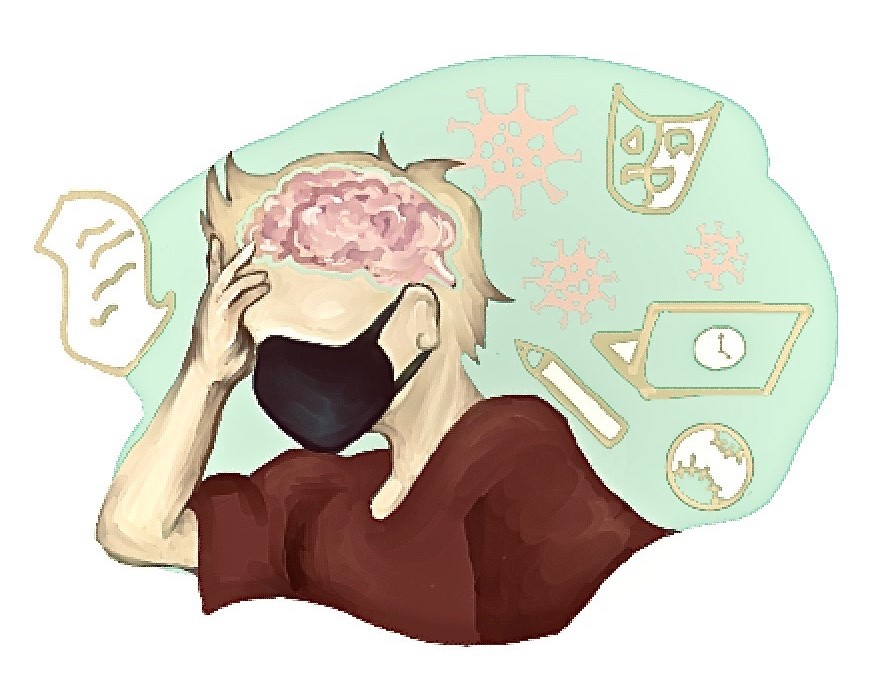COVID-19 Schooling and Mental Health

By: Amy Tan, Crystal Widado, Ciara Balanza
Edited by Phoebe Jeske
Introduction
High school students usually have a lot of stressors associated with school assignments, and college entrance tests like the SAT and ACT. This spring, when COVID-19 ravaged through the US and other countries, schools were shut down and remote learning substituted in-person classes. Now, in the back to school season, each state seems to have a different approach to educating children. These models fall into three categories: fully in-person, hybrid/blended, or fully remote.
In all of these models, students are bound to face challenges from the pandemic’s imprint into daily life. The online environment is a new territory for most students, which can cause undue stress. Also, physical distancing from friends and peers can feel socially isolating. In-person classes, although they seem to resemble pre-COVID-19 learning, must take measures to prevent the spread of COVID-19 and new safety precautions are anxiety-inducing to students. In addition, the threat of the pandemic on family health and its reverberations on the economy can also be outside factors that further diminish emotional health for students. In the time of COVID-19 education, it is essential to prioritize mental health.
Online learning stress
For many students, a consequence of online learning is increased stress. Part of this stress can be explained by the newness of it all. Most students have never experienced online learning before. This can cause stress for both students and teachers as they learn how to navigate a new platform and method of teaching. Along with the stress of managing a new way of learning, the stress of having to manage regular classes can be entirely different when quarantined and isolated at home.
One purpose of academic institutions is to promote learning in a collaborative environment. Considering the popularity of study groups, class discussions/debate, and community involvement, many students are more productive when working with others than by themselves. Peers give students motivation and healthy competition that pushes them to work towards success. With online learning, students can no longer easily talk with friends or make new connections with their classmates. By being isolated, students are deprived of the free coping mechanism provided by friends and the motivation to reach a student’s highest academic potential. Students are suddenly forced to solely rely on their internal motivation, instead of external motivation from others in the school building.
The physical and social-emotional activities that boost student’s fitness and wellness, are also impacted by COVID-19. Extracurriculars, ranging from sports and debate, are part of most student’s schedules, but now they are vastly changed or canceled. These extracurriculars are good for building social relationships between peers and creating a like-minded community where students feel they belong. An online school without these social activities can make students feel isolated and more alone in school stress. Still, mental health experts believe that even though COVID-19 has made it more difficult, finding ways to cope and create stability are vital to maintaining a healthy outlook. Overall, COVID-19 has shown to have multiple negative effects on student’s abilities to motivate themselves and adjust to their new reality in an online school, but teens can cope by connecting with friends and accessing school and online mental health support.
Social isolation’s effects
Although isolation concerns during COVID-19 are most evident in the elderly population, isolated adolescents are highly susceptible to mental and physical health concerns that extend into adulthood. From interactive school to sudden isolation is a stark and challenging transition that is more challenging for students with mental disabilities such as autism. Autistic students are particularly reliant on attentive, interpersonal communication or therapy as necessary treatment. No school or social contact significantly obstructs their set routine.
Also, growing research suggests that quarantined students are at a greater risk of suffering from comorbid anxiety disorders and alcoholism later in life. The correlation between loneliness and preteens is linked to depressive symptoms and suicidal behavior. Anxiety and depression from the pandemic can also contribute to long-term physical health risks, including high inflammation, obesity, and poor cardiovascular health.
Despite these consequences, a student’s personality can also determine their mental response to quarantine. Introverted students who prefer to be alone in their thoughts find socializing energy-consuming. These introverts may see the social-distancing order as a relief, while extroverted students feel lonely, anxious, and overwhelmed. Both introverts and extroverts can prevent loneliness by staying connected, following a structured daily schedule, and going outside (with precaution).
Masks and pods
Even students who are able to go back to a physical school, still have to endure substantial changes to the normal routine. There are numerous procedures to mitigate the spread of COVID-19. In most schools, all students have to wear masks, take a swab test, and fill out a health check to come into school. These procedures are in place to stop the spread of COVID-19, but they can also heighten the anxiety of students. Due to COVID-19, students always have to be careful, which is something many teens aren’t used to.
In addition, the physical distancing put in place by online schools may separate people from their friends. Since some schools are using pods to minimize a potential outbreak of the virus, students are advised to not intermix between pods. Even if students are in the same pod or are allowed to interact, fear of contracting the virus or giving it to others may make teens more apprehensive about being social with peers.
Works cited:
https://www.beyonddifferences.org/resources/consequences-of-social-isolation
https://files.eric.ed.gov/fulltext/EJ1184924.pdf
https://www.cdc.gov/coronavirus/2019-ncov/community/schools-childcare/parent-checklist.html
https://edsource.org/2020/coping-with-coronavirus-crisis-a-challenge-for-californias-students/6683